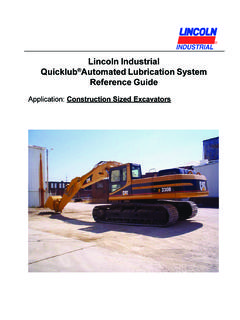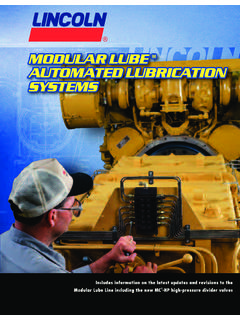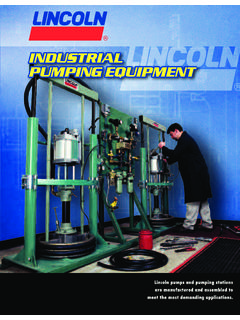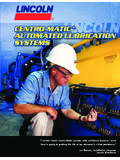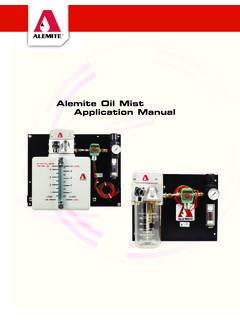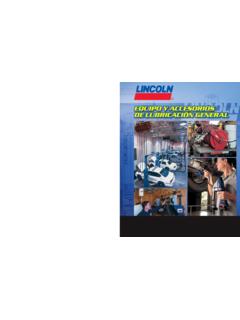Transcription of Capabilities - Lube Systems of California
1 Vo l . 1 , N o . 3. October 2004. Capabilities INFORMATION FROM THE LEADER IN THE LUBRICATION INDUSTRY. Lubrication Solutions for Food and Beverage Applications Inside: Technology from Pumps a Name You pageTrust 5. pg. 2. It's Your Choice Reels pg. page3 6. Lincoln Advantage Controls pg. page4 7. Centro-Matic . pg. 5 Guns Grease page 8. Quicklub &. Modular Lube . Used Fluids pg. page6 12. ORSCO . Systems pg. 7. Worldwide Distribution pg. 8. The Latest Technology from a name you trust Today's food and beverage manufacturers are constantly seeking new solutions and advanced technology to maintain freshness, reduce spoilage, and maximize their productivity.
2 The industry is moving toward science-based manufacturing requiring more automation. In this changing environment, proper lubrication of your high-speed advanced-technology machinery is essential. Food and beverage industries have some of the toughest environmental conditions for maintaining machinery. Moisture, extreme heat, extreme cold, product spills and sanitary washdown procedures all adversely affect lubrication processes and can severely reduce bearing life. Bearing failure and the resulting downtime may cause serious problems including lost production, spoilage and increased operating costs.
3 The Lincoln Advantage Lincoln has been inventing and improving lubrication practices for the food and beverage industry, agriculture, construction, mining, and the automobile industry since 1910. The company has been awarded more patents than all other lubrication system manufacturers combined. With so many innovations in lubrication, and a worldwide network of knowledgeable distributors, food and beverage manufacturers trust Lincoln quality and service. As the world leader in the lubrication industry, Lincoln designs and manufactures everything you need from automated lubrication Systems to a full line of manual lubrication tools and equipment.
4 2 Capabilities It's Your Choice: 3 Lubrication Options Automated Lubrication: Feeds All Points on a Machine while It's Operating Automated lubrication Systems feature a pump, with controls, that feeds lubricant to the metering devices, which deliver grease or oil in small, precise amounts at regular intervals to vital components while the machine is operating. The optimal time to lubricate the machine is during operation when all the surfaces that bear the load are continuously being exposed. In areas using heavy washdown or chemical sanitation methods, the system controls may be programmed to provide a pre-lubrication function that replaces lost lubricant before startup.
5 You can also choose to have our Systems installed with dedicated controls or utilize machine- based PLCs to schedule and monitor lubrication events. Centralized Lubrication: Feeds a Number of Components from a Single Point A more efficient method of lubricating than manual lubrication, the centralized system extends bearing life, improves safety and reduces maintenance cost. The machine operator uses a grease gun and applies lubricant to a conveniently placed central divider valve that feeds grease directly to every bearing while the machine is running.
6 It allows the operator to lubricate conveyor bearings in 10 percent of the time required in the point-to-point method. Centralized Systems eliminate the need to remove guarding in order to access lubrication fittings and can be used in all areas of food-processing facilities. Manual Lubrication: Performed Point-by-Point While less popular in the food and beverage industry today, point-by-point lubrication can be effective in applications that are difficult to centralize or automate but may include moving points or single fittings in remote locations.
7 Typically, machinery being manually lubricated is shut down for safety reasons. The initial cost for the equipment can be lower, but it is the most labor-intensive approach. Grease guns are available in manual and air- and battery-operated versions. What Automated Lubrication Can Do Apply Small Amounts of Lubricant Frequently Cut Operating Expenses Eliminate downtime costs for Too much lubricant = product contamination and breached seals bearing-related failures Reduce lost production and labor costs attributed to manual lubrication Automated Lubrication Stop product contamination often caused by over-lubrication Optimal Prevent accidents that can occur when manually lubricating Reduce lubricant.
8 Housekeeping Manual and energy costs Lubrication An investment in automated Too little lubricant = friction and wear lubrication will quickly pay for itself Capabilities 3. The Lincoln Advantage We Stand Up to Washdowns Because spoilage and contamination are ever-present problems, you use caustic washes and acid sprays to remove organic particles from machines, bottles and kegs. And you may also rely on a steam blast to sterilize your equipment. To endure this necessary but abusive treatment, we build our lubricating system components to resist corrosion.
9 We fabricate many of them from 304 or 316. stainless steel alloy and nickel-plated components. A History of Solving Lubrication Problems Lincoln began developing lubrication equipment in response to problems experienced in the mining industry more than 80 years ago. We developed our products and abilities to become a dominant supplier of lubrication equipment in agriculture, construction, automotive, process industries, manufacturing and, of course, the food and beverage industries. More Automatic Choices for Every Application From the industry's most popular Centro-Matic system to the internationally known Quicklub system, automated lubrication is Lincoln's continuously evolving answer to production challenges such as escalating costs for maintenance, energy and materials that our customers face every day.
10 Add our two-line Systems , modular progressive Systems and precise oil spray Systems and you'll realize that Lincoln offers more automated solutions than anyone. Specified by Top OEMs You will find Lincoln's centralized and automated Systems installed on food and beverage machinery manufactured around the world. Design engineers for these top equipment manufacturers know that Lincoln Systems work and that our representatives will be there to assist customers with the proper use of the Systems once they are delivered and ready to be put into operation.


